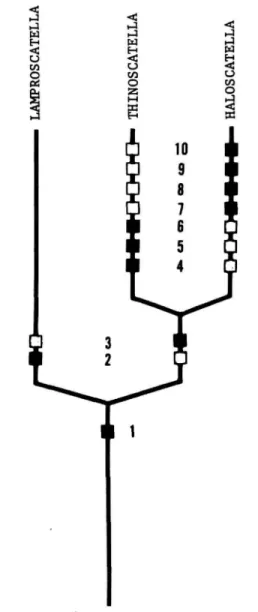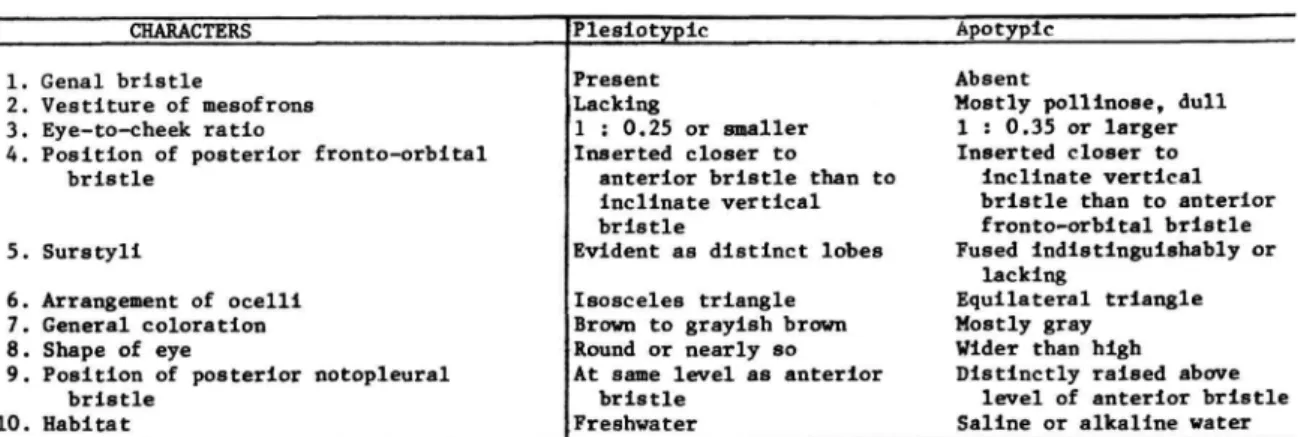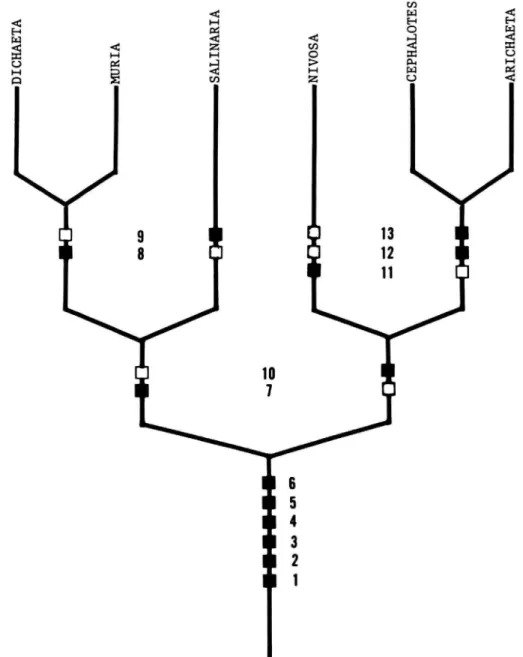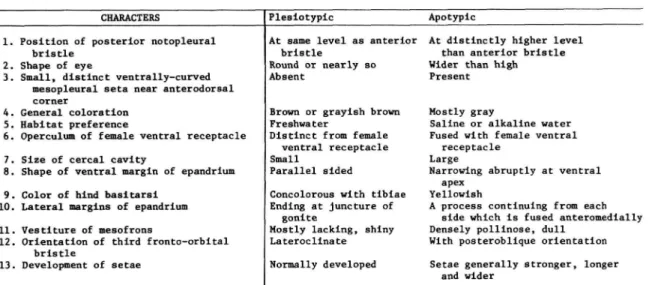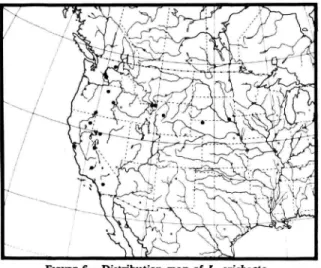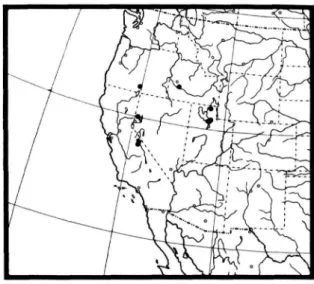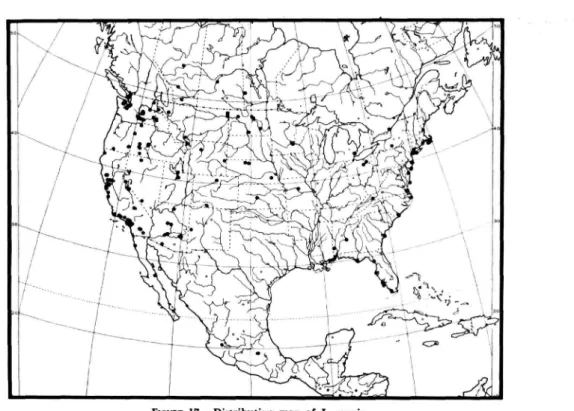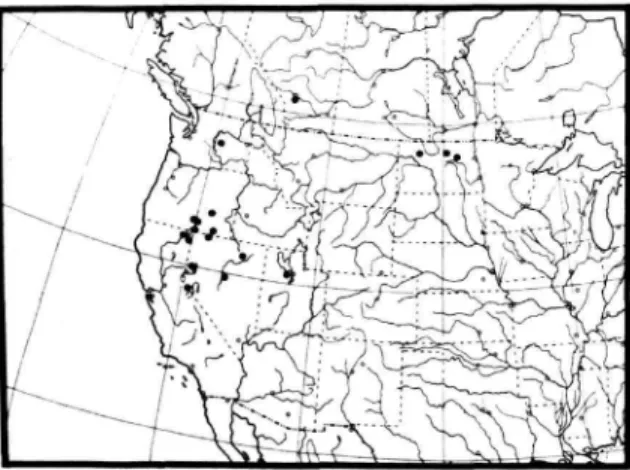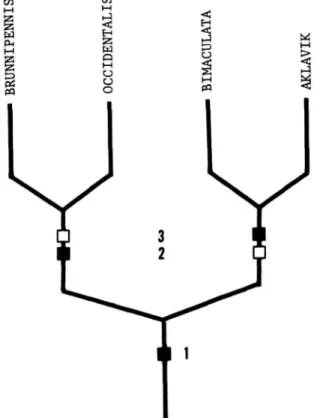Studies of Ephydrinae (Diptera: Ephydridae), II:
Phylogeny, Classification, and Zoogeography of Nearctic
Lamproscatella Hendel
WAYNE N. MATHIS
SMITHSONIAN CONTRIBUTIONS TO ZOOLOGY • NUMBER 295
Emphasis upon publication as a means of "diffusing knowledge" was expressed by the first Secretary of the Smithsonian. In his formal plan for the Institution, Joseph Henry outlined a program that included the following statement: "It is proposed to publish a series of reports, giving an account of the new discoveries in science, and of the changes made from year to year in all branches of knowledge." This theme of basic research has been adhered to through the years by thousands of titles issued in series publications under the Smithsonian imprint, commencing with Smithsonian Contributions to Knowledge in 1848 and continuing with the following active series:
Smithsonian Contributions to Anthropology Smithsonian Contributions to Astrophysics
Smithsonian Contributions to Botany Smithsonian Contributions to the Earth Sciences
Smithsonian Contributions to Paleobiology Smithsonian Contributions to Zoo/ogy Smithsonian Studies in Air and Space Smithsonian Studies in History and Technology
In these series, the Institution publishes small papers and full-scale monographs that report the research and collections of its various museums and bureaux or of professional colleagues in the world cf science and scholarship. The publications are distributed by mailing lists to libraries, universities, and similar institutions throughout the world.
Papers or monographs submitted for series publication are received by the Smithsonian Institution Press, subject to its own review for format and style, only through departments of the various Smithsonian museums or bureaux, where the manuscripts are given substantive review. Press requirements for manuscript and art preparation are outlined on the inside back cover.
S. Dillon Ripley Secretary
Smithsonian Institution
S M I T H S O N I A N C O N T R I B U T I O N S T O Z O O L O G Y • N U M B E R 2 9 5
Studies of Ephydrinae (Diptera: Ephydridae), II:
Phylogeny, Classification, and Zoogeography of Nearctic
Lamproscatella Hendel
Wayne N. Mathis
SMITHSONIAN INSTITUTION PRESS City of Washington
1979
Mathis, Wayne N. Studies of Ephydrinae (Diptera: Ephydridae), II: Phylogeny, Classification, and Zoogeography of Nearctic Lamproscatella Hendel. Smithsonian
Contributions to Zoology, number 295, 41 pages, 52 figures, 1979.—The nearctic species of Lamproscatella are revised. Keys to subgenera and species, illustrations, and distribution maps are provided. Lamproscatella is divided into three sub- genera, each of which is hypothesized to be monophyletic, being based on apotypic character states. The relationships among species within each subgenus are also outlined, again being based on apotypic character states. Assuming, among other assumptions, that the cladograms are reasonably correct, the zoogeography for each subgenus is discussed. I suggest that Lamproscatella had its origins in western North America and that through dispersal and subsequent vicariance events, the species of each subgenus differentiated and became more widespread in the North- ern Hemisphere. The subgenus Lamproscatella eventually dispersed to most of the Old World (including Africa and Asia), where further vicariance events resulted in the species occurring there now. As barriers to partition the range of ancestral species, I propose the existent topography of the Pliocene-Pleistocene coupled with the rather dramatic climatic events of these periods.
OFFICIAL PUBLICATION DATE is handstamped in a limited number of initial copies and is recorded in the Institution's annual report, Smithsonian Year. SERIES COVER DESIGN: The coral Montastrea cavernosa (Linnaeus).
Library of Congress Cataloging in Publication Data Mathis, Wayne N
Studies of Ephydrinae {Diptera: Ephydridae), II.
(Smithsonian contributions to zoology ; no. 295) Bibliography: p.
1. Lamproscatella. 2. Insects—Latin America. I. Title. II. Series: Smithsonian Institution.
Smithsonian contributions to zoology ; no. 295.
QLl.S54no. 295 [QL537.E7] 591'.08s [595.774] 79-518
Contents
Page
Introduction 1 Methods 2 Acknowledgments 3 Genus Lamproscatella Hendel 3
Key to Subgenera of Lamproscatella 6 Haloscatella, new subgenus 6 Key to Species of the Subgenus Haloscatella 8 1. Lamproscatella (Haloscatella) arichaeta, new species 9 2. Lamproscatella (Haloscatella) cephalotes Cresson 10
3. Lamproscatella (Haloscatella) muria, new species 12 4. Lamproscatella (Haloscatella) nivosa Cresson 16 5. Lamproscatella (Haloscatella) salinaria (Sturtevant and Wheeler) 18 Thinoscatella, new subgenus 20 Key to Males in Species of the Subgenus Thinoscatella 21 6. Lamproscatella (Thinoscatella) lattini, new species 21 7. Lamproscatella (Thinoscatella) quadrisetosa (Becker) 24 Subgenus Lamproscatella, sensu stricto 25 Key to Males in Species of the Subgenus Lamproscatella, sensu stricto 26 8. Lamproscatella (Lamproscatella) aklavik, new species 27 9. Lamproscatella (Lamproscatella) bimaculata Hendel 28 10. Lamproscatella (Lamproscatella) brunnipennis (Malloch) 30 11. Lamproscatella (Lamproscatella) occidentalis, new species 32 Zoogeography 36 Literature Cited 40
H I
Studies of Ephydrinae (Diptera: Ephydridae), II:
Phylogeny, Classification, and Zoogeography of Nearctic
Lamproscatella Hendel
Wayne N. Mathis
Introduction
Members of the shore fly family Ephydridae are notable because of their ability to successfully in- habit diverse and often inhospitable environments.
Frog and spider eggs, snails, human cadavers, salt lakes, crude petroleum or cess pools, and bubbling sulfur springs are among the habitats that are fre- quented by various species of the family. Within the family, many members of the subfamily Ephydrinae are halophilous and are commonly referred to as brine flies. The genus Lamproscatella belongs to this subfamily. Like related taxa, many of the included species have a physiological ability to withstand the osmotic pressure of salty environments. In west- ern North America, these flies are often extremely abundant on the crystaline-mud playas that are ex- posed to receding water levels of shallow alkaline or saline lakes in late summer. Other species of Lamproscatella are usually associated with fresh- water systems or with maritime estuaries.
A paucity of natural history data for Lamprosca- tella species precludes a meaningful synthesis at this time. Neither the immature stages nor the life cycle of any species has been described, and what data
Wayne N. Mathis, Department of Entomology, National Museum of Natural History, Smithsonian Institution, Wash- ington, D. C. 20560.
we do have on their ecology consist of very general- ized habitat descriptions. Dahl (1959), Deonier (1965), and Scheiring and Foote (1973) summarize available information for species occurring in the Nearctic Region.
The composite distribution of Lamproscatella species ranges nearly worldwide, although most spe- cies seem to be limited to one zoogeographic region.
The holarctic Lamproscatella quadrisetosa (Becker), L. bimaculata Hendel, and L. brunnipennis (Mal- loch) are exceptions. No species has been described from the Neotropics or Australia. Becker's (1919) record of L. sibilans (Haliday) from Ecuador is an error. Through the kindness of Dr. Loic Ma tile, I have examined the specimens Becker studied and found that they represent a species of the genus Scatophila Becker.
A detailed historical account of Lamproscatella is not within the scope of this paper. Many citations, especially those of the nineteenth century, are sim- ple species lists, published in conjunction with various faunistic studies. For the most part, these references are not cited below, and only papers containing keys, illustrations, or what I consider to be substantial contributions are included.
Hendel proposed Lamproscatella in 1917, al- though two years earlier Becker (1915) recognized 1
that the species later included in Hendel's new genus were a separate group but within the genus Scatella Robineau-Desvoidy. Indeed, those species described prior to Hendel's proposal of Lamprosca- tella but which were later included, were treated in the genus Scatella by most workers (Loew, 1860:40;
Schiner, 1863:265-266; Becker, 1896:228-229, 1905:
210-212, 1915:132; Jones, 1906:197; Grunberg, 1910:229-300). However, the type-species of the genus, L. sibilans (Haliday), was orginally described in the genus Ephydra (Haliday, 1833) and early Scandinavian dipterists continued to follow this precedent (Stenhammar, 1844:180; Zetterstedt, 1846:1832).
Since Hendel's description of Lamproscatella, its status has vacillated between generic and subgeneric levels. Becker (1926) treated Lamproscatella as a subgenus of Scatella in his synopsis of palearctic Ephydridae. This precedent was also followed by Collin (1930) in a review of the Scatella species of the British Isles, by Dahl (1959) in a study of Scan- dinavian Ephydridae, by Sturtevant and Wheeler (1954) when they reviewed the nearctic species, and by Deonier (1964) in a key to the shore flies of Iowa (United States). Cresson (1930), although sympa- thetic with the subgeneric status given by Becker, kept Lamproscatella as a distinct genus. Wirth and Stone (1956) and Wirth (1965) likewise recognized Lamproscatella as a distinct genus in treatments of the aquatic Diptera of California and in the recent catalog of North American Diptera respectively.
More recently, Andersson (1975) treated Lampro- scatella as a genus in his synopsis of the northern European species, as did Papp (1975) in an excel- lent faunistic study of the Ephydridae of Hungary.
The present study was initiated after I discovered that many species are undescribed or difficult to identify from existing literature sources. Names of species occurring in the Palearctic Region have been used for similar species occurring in North America or for nominate taxa which prove to con- sist of more than one species. The study is based primarily on the morphology of male and female terminalia, together with a reevaluation of other previously used characters. In the resulting classi- fication, Lamproscatella is considered a valid genus as characterized by Hendel, by Cresson (1930), and Wirth (1948). In addition, three subgenera are pro- posed, and five new species are described. The basis
for these proposals will be discussed in greater de- tail under the appropriate taxon.
METHODS.—During the course of this study, nearly 4500 specimens from most major North American collections were examined. Label data for all specimens examined were recorded, organized alphabetically, and presented under the appropriate species. Abbreviations of institutions where speci- mens are deposited are those cited in the "Acknowl- edgments" section. Type-specimens of all nominate taxa except for L. bimaculata Hendel were studied.
Label data accompanying each type are cited as given, with slashes to separate data of one label from another. Clarifying or interpretive comments are included parenthetically.
Cladograms outlining probable phylogenetic rela- tionships have been constructed for subgenera and for species included within each subgenus. The philosophic basis for constructing the cladograms is cladistic (Hennig, 1966). Character states were ar- ranged into transformation series and their relative ancestral or derived conditions were determined, generally by ex-group comparison. Monophyletic sister-group lineages were thus identified. Tables accompanying the cladograms list character state evidence; numbers assigned to characters corre- spond with those on the cladograms (filled squares = apotypic character states; outlined squares = plesiotypic character states).
Most characters employed in this study need no explanation. The characters listed below, however, are defined to avoid confusion.
Eye-to-cheek ratio: Genal height/eye height- Measurements are taken from the head in lateral view.
Head width-to-height ratio: Head height/head width as measured from an anterior view.
Costal vein ratio: The straight line distance be- tween R2+3 and R4+5/distance between Rx and R2+3. M1+t vein ratio: The straight line distance along M1+2 basad of posterior crossvein/distance apicad of posterior crossvein.
The terminology of male and female terminalia is that of Mathis (1975) except for the hypandrial process which I now call the gonite, a more widely used term. These structures were drawn with the aid of a drawing tube attached to a Wild M20 com- pound microscope.
Measurements or ratios cited in the text are based on an average of six specimens. The specimens were
NUMBER 295
selected as follows: the largest male and female; the smallest male and female; two other specimens picked randomly.
Descriptions are composite. For the most part, in- formation given in the generic or subgeneric de- scriptions is not repeated in the species descriptions.
ACKNOWLEDGMENTS.—Without the cooperation and assistance of numerous persons, much of this study could not have been completed. I am grate- ful to them all for their time, effort, and thoughtful consideration.
I thank the following curators and institutions for loaning specimens (an asterisk indicates collec- tions from which type specimens were borrowed).
AMNH American Museum of Natural History, New York (Dr. Pedro W. Wygodzinsky)
ANSP# Academy of Natural Sciences of Philadelphia (Dr.
Daniel Otte)
BYU Brigham Young University (Dr. Stephen L. Wood) CAS California Academy of Sciences (Dr. Paul H. Ar-
naud, Jr.)
CNC Canadian National Collection (Mr. Guy E. She- well)
CU Cornell University (Dr. L. L. Pechuman)
FSCA Florida State Collection of Arthropods (Dr. How- ard V. Weems)
HU Museum fur Naturkunde, Humbolt Universitat, Berlin (Dr. H. Schumann)
ISU Iowa State University (Dr. Robert E. Lewis) KNSU Kansas State University (Dr. H. Derrick Blocker) KU# University of Kansas, Snow Entomological Mu-
seum (Dr. George W. Byers)
KSU Kent State University (Dr. Ben. A. Foote) MSU Michigan State University (Dr. Roland L. Fischer) MCZ Museum of Comparative Zoology, Harvard Uni-
versity (Margaret Thayer)
NMW Naturhistorisches Museum, Wien (Dr. Ruth Lichtenberg)
OSDA Oregon State Department of Agriculture (Mr.
Richard L. Westcott)
OSU Oregon State University (Dr. John D. Lattin) PSU Pennsylvania State University (Dr. K. C. Kim) UCD University of California, Davis (Dr. Robert O.
Schuster)
UCR University of California, Riverside (Mr. Saul I.
Frommer)
UMI University of Michigan (Dr. Thomas E. Moore) UMN University of Minnesota (Dr. Philip J. Clausen) USNM* former United States National Museum, collections
in the National Museum of Natural History, Smithsonian Institution
USU Utah State University (Dr. Wilford J. Hanson) WSU Washington State University (Dr. William J.
Turner)
Hollis B. Williams prepared all of the maps and organized the locality data; L. Michael Drucken-
brod rendered the habitus illustrations; Anne Hal- pern typed the final draft. An earlier draft of this paper was read and critiqued by Wayne E. Clark and W. W. Wirth.
Genus Lamproscatella Hendel
Lamproscatella Hendel, 1917:42 [type-species: Ephydra sibi- lans Haliday, by original designation].—Cresson, 1930:125- 126.—Wirth, 1948:278-280; 1965:756.—Wirth and Stone, 1956:474-475.
Scatella (Lamproscatella) Becker, 1926:84-86.—Collin, 1930:
133-139.—Dahl, 1959:117-119.—Sturtevant and Wheeler, 1954:175-176.
DIAGNOSIS.—Specimens of Lamproscatella are sim- ilar to those of several genera of Scatellini but may be distinguished by the following combination of characters: Antennal arista pubescent to bare, not bearing pectinate dorsal branches; genal bristle lacking or reduced, subequal to other genal setae;
acrostichal setae in 2 rows, although none well de- veloped except possibly for a prescutellar pair; 3 pair of dorsocentral bristles (1 + 2), hind pair slightly displaced laterally; wings generally immac- ulate; costal vein extending to apex of vein M1+2. DESCRIPTION.—Small to moderately small shore flies, length 1.25 to 2.90 mm; face arched, protrud- ing; body coloration generally subdued, gray to dark brown.
Head: Face prominent, arched, setulose. Frons wider than high, often with distinct, shiny meso- frons that contrasts with duller, pollinose parafrons, frons otherwise uniformly dull colored, mesotrons of some species with small setae along margin or generally scattered over surface. Ocellar triangle raised in relief from mesofrons; dull, polliflose, fre- quently contrasting with mesofrons if mesofrons shiny; ocelli arranged to form equilateral or isos- celes triangle, sometimes brightly colored; 1 pair of large, proclinate, divergent ocellar bristles, 1-3 pair of much smaller, divergent postocellar setae be- tween or posterior of posterior pair of ocelli. Gen- erally only 2 pair of prominent, lateroclinate fronto- orbital bristles, although a smaller seta is usually present anterior of and between larger pair; 2 pair of vertical bristles; postocular setae variously de- veloped, usually subequal to postocellar setae. An- tenna dark colored, second segment setose, espe- cially toward ventral, median, and dorsal surfaces;
arista pubescent; length of arista variable. Marginal
facial setae larger and often with 1-2 pair of dorsally-curved larger setae toward lateral margins.
Eye round to oval; eye-to-cheek ratio 1 :0.17-0.60.
Oral opening large; clypeus concealed; maxillary palp small, dark colored; prementum large, bul- bous, setose.
Thorax: Mesonotum mostly pollinose, dull col- ored to subshiny, generally unicolorous but usually with faintly evident, dark and light colored vittae, especially along setal tracts; presutural portion often with some partially shiny metallic areas;
scutellum either concolorous or slightly lighter in color than mesonotum; pleural areas generally con- colorous with mesonotum. Chaetotaxy of thorax as follows: Acrostichal setae in 2 rows, setae generally subequal to each other, small, 1 pair of presutural bristles; 3 pair of dorsocentral bristles (1 + 2), posterior pair inserted laterad of alignment of other dorso-centrals, often with a few smaller setae between larger bristles; 1 pair of postalar bristles;
several smaller intra-alar setae generally between larger bristles; 2 pair of lateral scutellar bristles, pos- terior pair better developed; 2 pair of notopleural bristles; 1 larger mesopleural bristle inserted near posterior margin, several smaller setae, especially toward anterior and posterior margins; 1 larger sterno-pleural bristle, generally 1 smaller bristle anterior of larger one. Legs mostly concolorous with pleural areas, some species with pale basitarsi. Wing mostly immaculate, hyaline to slightly infumated;
Setae along costal margin well developed in some species, otherwise normally developed. Costal vein ratio from 1 : 0.14-0.24, with considerable intra- specific variation; costal vein extending to apex of vein M1+2. M1+1! vein ratio from 1 : 0.54-0.70. Halter pale, yellow to white.
Abdomen: Males with 5 visible terga, females with 6-7. Coloration more or less uniform, some- times slightly darker toward margins; dorsal setae small and scattered. Structures of male terminalia symmetrical, reduced, consisting of andrium only, see subgeneric descriptions for further detail.
Female terminalia consisting of terga 6-8 and sterna 6, 7 + 8, and 9. Sterna 7 + 8 and 9 paired, sym- metrical, setose, but lacking spines. Ninth tergum possibly fused with terminal cerci. Female ventral receptacle variously shaped, see descriptions of sub- taxa.
FIGURE 1.—Hypothetical phylogeny for the subgenera of Lamproscatella, based on the character states outlined in Table 1. (Solid squares = apotypic character states; open square = plesiotypic character states.)
DISCUSSION.—Within the tribe Scatellini, Lam- proscatella is one of the more problematic genera.
Its relationships with other genera are poorly under- stood, and its status has been unstable historically.
It has been variously treated as a "valid" genus or
NUMBER 295
TABLE 1.—Characters and character states used in cladistic analysis of the subgenera of Lamproscatella
CHARACTERS 1. Genal bristle
2. Vestiture of mesofrons 3. Eye-to-cheek ratio
4. Position of posterior fronto-orbital bristle
5. Surstyli
6. Arrangement of ocelli 7. General coloration 8. Shape of eye
9. Position of posterior notopleural bristle
10. Habitat
Plesiotypic Present Lacking
1 : 0.25 or smaller Inserted closer to
anterior bristle than to inclinate vertical bristle
Evident as distinct lobes Isosceles triangle Brown to grayish brown Round or nearly so At sane level as anterior
bristle Freshwater
Apotypic Absent
Mostly pollinose, dull 1 : 0.35 or larger Inserted closer to Inclinate vertical bristle than to anterior fronto-orbital bristle Fused lndlstlnguishably or
lacking
Equilateral triangle Mostly gray
Wider than high Distinctly raised above
level of anterior bristle Saline or alkaline water
as a subgenus of Scatella. The latter is clearly un- tenable. There is now substantial evidence (Mathis and Shewell, 1978) to indicate the monophyly and relationships of Scatella and related genera, not to include Lamproscatella.
Two general problems are evident. One concerns the monophyly of Lamproscatella; the other con- cerns its relationships within the tribe.
Because convincing evidence is lacking, the hy- pothesis of monophyly of Lamproscatella must be considered provisional. The status and composition of the genus as herein defined are traditional and lack an objective basis. Further resolution of rela- tionships will depend on accumulation of evidence of relationships in related taxa.
The one character state that is possibly apotypic is the traditional "key" character for the genus—a conspicuous genal bristle is either lacking or much reduced (genal setae are present, and one could be the reduced genal bristle). But the apparent loss of a simple structural feature, such as this one, is not convincing evidence of relationship because of the likelihood of its independent occurrence in various lineages. Thus, the possibility that Lamproscatella is paraphyletic cannot be discounted.
As for generic relationships, my assessment is that Lamproscatella is closely related to Philotelma Becker and Coenia Robineau-Desvoidy, although these relationships are primarily patristic, being
based on plesiotypic character states (see generic diagnosis). Character states distinguishing speci- mens of these two genera from those of Lampro- scatella are as follows: Specimens of Coenia are generally darker colored, have a pectinate arista, four pair of dorsocentral bristles, a conspicuous genal bristle, parafrons generally concolorous with shiny mesofrons, and have distinct male terminalia (Mathis, 1975); specimens of Philotelma are smaller, have a pectinate arista, and distinctive male ter- minalia.
The preceding problems are further complicated by the relatively large degree of structural diversity exhibited within Lamproscatella^ itself. I have divided Lamproscatella into three subgenera, and the distinguishing gap between each is greater than for some so-called genera of the Scate//a-related complex of genera. The differences between Neo- scatella Malloch and Scatella, for example, are con- siderably less. The species in each subgenus, how- ever, are fairly uniform, and there is little doubt as to which subgenus a particular species belongs. Sim- ilarity or lack thereof, however, is not necessarily an indication of relationship.
The relationships among the subgenera are as outlined in the cladogram (Figure 1) and Table 1.
The relationships within each subgenus are dis- cussed separately in their respective discussion sec- tions.
Key to Subgenera of Lamproscatella
1. Posterior notopleural bristle inserted approximately midway between dorsal angle and poste- rior angle, at distinctly higher level than anterior bristle; eye wider than high, generally oriented at slight oblique angle to oral margin Haloscatella, new subgenus Posterior notopleural bristle closer to posterior angle than to dorsal angle, at approximately same level with anterior bristle; eye slightly higher than wide, appearing round 2 2. Posterior fronto-orbital bristle inserted closer to inclinate vertical bristle than to anterior
fronto orbital bristle; eye-to-cheek ratio 1 : 0.35 or more; mesotrons shiny
Thinoscatella, new subgenus Posterior fronto-orbital bristle inserted closer to anterior fronto-orbital bristle than to
inclinate verticle bristle; eye-to-cheek ratio 1 : 0.25 or less; mesofrons at most subshiny Lamproscatella Hendel
Haloscatella, new subgenus
TYPE-SPECIES.—Lamproscatella (Haloscatella) art- chaeta Mathis, new species, by present designation.
SPECIES INCLUDED.—Lamproscatella arichaeta, new species; L. cephalotes Cresson; L. muria, new species; L. nivosa Cresson; L. salinaria (Sturtevant and Wheeler).
DIAGNOSIS.—Specimens of this subgenus are very distinctive and may be separated from those of Thinoscatella and the nominate subgenus by the following combination of characters: Coloration of most species generally grayer and more pollinose, particularly on face, pleural areas, and abdomen;
eye-to-cheek ratio at least 1:0.50; eye obliquely oriented to general plane of head; facial setae grad- ually becoming longer toward oral margin; setae along oral margin only slightly longer than those above; a distinctive, large, slightly dorsally curved facial bristle near posteroventral angle of face, ap- proximately in line with anterior margin of eye;
face in profile more protruding; insertion of poster- ior notopleural bristle distinctly elevated above level of anterior bristle; a distinct dorsally curved bristle toward anterodorsal corner of mesopleuron;
acrostichal setae weak, sparse, seriated into two rows that sometimes converge or overlap each other; pre- scutellar setae well developed, differing distinctly from other acrostichal setae by being more widely set apart. The male terminalia of the subgenus are morphologically diverse, and in most species, the structures appear to have undergone considerable modification. For species of one lineage, a unique condition exists, wherein secondary extensions of the hypandrium fuse beneath the internal genitalia to form a well sclerotized bridge. The operculum of the female ventral receptacle is broadly fused to the extending process, the latter is wide and
rounded; the paired, extending receptacle processes have parallel sides or taper evenly, lacking a median swelling.
ETYMOLOGY.—Haloscatella is a combination of the Greek halo ("salt") and scatella, referring to the brackish-water habitats of these Scatella-like flies.
GEOGRAPHIC DISTRIBUTION.—With the exceptions of L. dichaeta (Loew) (disjunct Old World distribu- tion) and possibly L. fluvialis Miyagi (Japan), mem- bers of this subgenus occur only in the Western Hemisphere. Their present center of diversity ap- pears to be western North America, where most species have widespread distributions. Although some species occur along the coasts, they are more abundant inland, especially around the salt-caked shores of shallow saline or alkaline lakes.
NATURAL HISTORY.—Members of this subgenus are distinctly halophilous and seem to proliferate best where saline or alkaline conditions are near saturation. In late summer, when the water level has lowered and exposed more shoreline around many of the shallow lakes of western North Amer- ica, species of the subgenus are often found in great abundance. As the newly exposed shoreline dries, a white, crystaline layer of salt is formed on the surface, and cracks begin breaking the upper layers of sediment into smaller portions. Within the cracks thousands of flies are frequently encountered. The cracks probably provide protection from heat and the bottoms are the only nearby source of moisture.
Scheiring and Foote (1973) also collected Halo- scatella from small pools of saline water formed from drainage of a larger brine storage and of a salt plant near Rittman, Ohio.
DISCUSSION.—Members of Haloscatella are quite homogeneous in overall appearance and are un- likely to be confused with members of the other subgenera. Superficially they are quite similar to
NUMBER 295
some primitive members of the genus Scatella Robineau-Desvoidy, i.e., S. paludum (Meigen), S.
favillacea Loew, and S. lutosa (Haliday). The charac- ter states that align these species with Lampro- scatella are primitive (plesiotypic) and an examina-
tion of the unique chaetotaxy, structures of the male and female terminalia, and spotted wings (some- times faint) should quickly eliminate any confusion of generic association.
A suggested phylogeny of the species included in
FIGURE 2.—Hypothetical phylogeny for the species of the subgenus Haloscatella, based on the character states outlined in Table 2. {Solid squares = apotypic character states; open squares = plesiotypic character states.)
TABLE 2.—Characters and character states used in cladistic analysis of the species of the subgenus Haloscatella
CHARACTERS
1. Position of posterior notopleural bristle
2. Shape of eye
3. Small, distinct ventrally-curved mesopleural seta near anterodorsal corner
4. General coloration 5. Habitat preference
6. Operculum of female ventral receptacle 7. Size of cereal cavity
8. Shape of ventral margin of epandrium 9. Color of hind basitarsi
10. Lateral margins of epandrium 11. Vestiture of mesofrons
12. Orientation of third fronto-orbital bristle
13. Development of setae
Plesiotypic
At same level as anterior bristle
Round or nearly so Absent
Brown or grayish brown Freshwater
Distinct from female ventral receptacle Small
Parallel sided
Concolorous with tibiae Ending at juncture of
gonite
Mostly lacking, shiny Lateroclinate Normally developed
Apotypic
At distinctly higher level than anterior bristle Wider than high Present
Mostly gray
Saline or alkaline water Fused with female ventral
receptacle Large
Narrowing abruptly at ventral apex
Yellowish
A process continuing from each side which is fused anteromedially Densely pollinose, dull
With posteroblique orientation Setae generally stronger, longer
and wider
Haloscatella is proposed as outlined in Figure 2, and Table 2, which lists character states. The mono- phyly of Haloscatella is well established as indicated by the number of autapotypies.
In addition to species of the Nearctic fauna, two others are included in this subgenus: L. dichaeta (Loew, 1860; Europe and South Africa) and L.
fiuvialis Miyagi (1977; Japan). Specimens of L.
dichaeta are very similar to those of L. muria, and except for structures of the male terminalia, cannot be distinguished. I have not examined specimens of L. fiuvialis, but Miyagi (1977) compared L. fiu- vialis with L. dichaeta in his diagnosis of the former, so I suspect the two are closely related.
Key to Species of the Subgenus Haloscatella
1. Mesofrons dull, mostly pollinose, not distinctly contrasting in color or texture with parafrons, blending gradually with parafrons 4. L. nivosa Cresson Mesofrons usually subshiny to shiny, distinctly contrasting with parafrons 2 2. Third fronto-orbital seta much reduced, length less than half that of first, inserted mesad of
alignment of other fronto-orbitals, much closer to second than to fourth, orientation nearly reclinate 3 Third fronto-orbital seta larger, at least one-half length of first, inserted only slightly closer to second fronto-orbital than to fourth, orientation lateroclinate 4 3. Mesonotum with considerable gray coloration; dorsum of scutellum mostly gray; each sur- stylus more or less parallel-sided, fingerlike, densely setose along median surface; width of gap between surstyli less than width of surstylus 2. L. cephalotes Cresson Mesonotum and scutellum mostly brown; surstylus gradually tapering from base to apex;
width of gap between surstyli about equal to length of surstylus, much greater than width of surstylus 1. L. arichaeta, new species 4. Mesofrons shiny, subquadrate, broadly reaching frontal suture; basitarsi pale, yellowish;
disc of mesonotum generally gray; larger species, length generally greater than 1.75 mm....
5. L. salinaria (Sturtevant and Wheeler) Mesofrons subshiny to shiny, lateral margins distinctly narrowing anteriorly, shiny area
often weak anteromedially, dull; smaller species, length generally less than 1.65 mm
• — 3. L. muria, new species
NUMBER 295 9 1. Lamproscatella (Haloscatella) arichaeta,
new species
FIGURES 3-6
DIAGNOSIS.—Although specimens of L. arichaeta appear to be very similar to those of L. cephalotes, they may be distinguished from the latter by the following combination of characters: Specimens averaging smaller in overall size; setal development much less pronounced; mesonotum generally more brownish. The male terminalia of L. arichaeta males differ markedly from those of L. cephalotes males, being smaller and of a unique conforma- tion, particularly the shape of the surstyli (Figures 3-5).
DESCRIPTION.—Small to moderately small shore flies, length 1.70 to 2.45 mm (averaging 2.00 mm);
generally brownish gray, with some extensive brown colored areas.
Head: Head width-to-height ratio averaging 1:0.74; coloration whitish gray to brown. Meso- frons subshiny to shiny with metallic brown to blu- ish green luster, subtriangular, rounded anteriorly, with 1-2 pair of small setae marginally; parafrons mostly charcoal gray, ocellar triangle pollinose, brown. Anterior fronto-orbital seta large, length at least one-half that of larger, posterior bristles;
third fronto-orbital seta much reduced, inserted mesad of line of other bristles, very close to second bristle, oriented at posteroblique angle to other fronto-orbitals. Dorsalmost postocular seta more strongly developed than remaining postoculars, in- serted posterolaterad of divergent vertical bristle.
Antennal segments dark colored, mostly blackish, pollinose; arista slightly longer than combined length of second and third segments. Face whitish gray, densely pollinose to tomentose, protruding and arched; lateral facial setae larger than median ones, becoming larger toward posteroventral angle of face; setae along oral margin only slightly larger than median facial setae. Eye-to-cheek ratio aver- aging 1 : 0.47; gena concolorous with face; 2-3 para- facial setae.
Thorax: Dorsum mostly light brown, becoming grayer on pleural areas, especially toward venter.
Scutellum lighter brown in coloration than disc of mesonotum. Setation quite pronounced and well developed. Legs becoming darker toward apices;
apical tarsomeres mostly black. Wing hyaline to faintly infumated with grayish brown coloration:
costal margin only slightly setose; costal vein ratio averaging 1 : 0.17; M14J2 vein ratio averaging 1 : 0.55;
posterior crossvein with posterior half slightly angu- late laterally, wrinkled in middle.
Abdomen: Generally grayer than dorsum of tho- rax, but also with considerable brown coloration.
Male terminalia with surstyli fused to epandrium and forming open triangle with pocket formed by paired arms U-shaped and shallow (Figures 3-5).
TYPE MATERIAL.—Holotype male is labeled:
"WASH Grant Co Soap Lake 5 August 1973 Wayne Mathis/HOLOTYPE Lamproscatella arichaeta W N Mathis (red)." Allotype female and 46 paratypes (10 cT, 3 6 ? ; USNM) have the same locality data as the holotype. Other paratypes are as follows:
Oregon, Harney Co., Borax Lake, 7.2 km NE Fields, 29 Jul 1975, W. N. Mathis (Id1, 1 $ ; USNM);
Malheur Co., 24.2 km NW Yale, 28 Aug 1965, Kenneth Goeden (1$; USNM); Lake Co., Goose Lake State Park, 23 Aug 1970, Karl W. Simpson (Id1, 3 $ ; CU). The holotype is in the National
FIGURES 3-5.—L. arichaeta: 3, epandrium, surstyli, and cerd, posterior aspect; 4, epandrium, surstyli, and cerci, lateral aspect; 5, internal male terminalia, lateral aspect.
Museum of Natural History, Smithsonian Institu- tion, Washington, D. C , type number 75956.
OTHER SPECIMENS EXAMINED.—UNITED STATES: CALI- FORNIA: Kern Co., Onyx, 23 Jul 1940, D. E. Hardy <1 $, 2 9 ; KU, USNM); Lassen Co., Hallelujah Junction, 4 Jul 1949, P. D. Hurd (1 $ ; USNM). Spauldings, 27 Jul 1949, P. D. Hurd
< 2 9 ; USNM); Mono Co., Mammoth Lakes, 29 July 1949, L. J. Lipovsky (4$; KU); Riverside Co., Palm Springs, 24-26 Mar 1918, J. C. Bradley (1 9 ; CU). MONTANA: Fire Hole River, 27 Aug 1940, A. L. Melander (1 $, USNM). NEBRASKA: Cherry Co., Big Alkali Lake, 2 Jun 1969, W. W. Wirth (1 $, USNM), Twin Lake, 2 Jun 1969, W. W. Wirth ( 3 $ , 1 1 9 ; USNM).
NEVADA: Churchill Co., Soda Lakes near Hazen, 13 Jul 1911 ( 1 9 ; USNM). OREGON: Union Co., North Powder, 13 Jun 1971, R. H. Beamer (1$; USNM). SOUTH DAKOTA: Yankton Co., Gavins Point, 17 Jun 1969, W. W. Wirth (1 $; USNM).
WASHINGTON: Grant Co., O'Sullivan Dam, 23 May 1954, 19 Jul 1955, M. T . James (3 3 ; WSU), Soap Lake, 24 July 1919.
A. L. Melander ( 1 3 , 2 9 ; USNM), Soda Lake near O'Sullivan Dam, Columbia National Wildlife Refuge, W. L. Turner (1 9 ; WSU), Warden Lake, Columbia National Wildlife Refuge, 16 Aug 1977, R. S. and V. L. Zack ( 2 9 ; WSU); Stevens Co., Evans, 13 June 1930, R. C. Shannon ( 1 £ , 1 9 ; USNM).
WYOMING: Hot Springs Co., Thermopolis, 13 Jun 1969, W. W.
Wirth <2 9 ; USNM); Teton Co., Yellowstone National Park, U Geyser Basin, 7 Aug 1916, A. L. Melander ( 3 9 I USNM).
GEOGRAPHIC DISTRIBUTION. {Figure 6).—This spe- cies occurs mainly west of the 100th meridian between 32° and 49° north latitude.
ETYMOLOGY.—The epithet arichaeta is a combi- nation of the Greek ari ("very" or "much") plus chaeta ("bristle"), in allusion to the pronounced setation of specimens of this species.
REMARKS.—Specimens of L. arichaeta were con- fused with those of L. cephalotes. Like the latter,
FIGURE 6.—Distribution map of L. arichaeta.
they are associated with aquatic systems that have an unusually high salt content. The type-locality, Soap Lake, is a popular recreational area in central Washington because of its dry, sunny climate, and because the lake water contains a variety of dis- solved salts that are reputed to endow frequent bathers with improved health. The water margin is generally outlined with an accumulation of foam, hence the name for the lake. The sandy banks are an ideal habitat for tiger beetles (Cicindelidae) and other shore fly species. Specimens of L. muria also occur in abundance along the banks.
The extent and degree of brown coloration on the dorsum of specimens of this species, particu- larly on the mesonotum, displays considerable vari- ability. In general, however, the brown coloration is better developed than in specimens of L. cepha- lotes. Care should be exercised in emphasizing either of these characters and if there is doubt, reference to the characters of the male terminalia should eliminate confusion.
2. Lamproscatella (Haloscatella) cephalotes Cresson
FIGURES 7-13
Lamproscatella cephalotes Cresson, 1935:360.—Wirth and Stone, 1956:475 [key, distribution in California].—Wirth, 1965:756 [catalog].
DIAGNOSIS.—This species and L. arichaeta are closely related as evidenced by their overall simi- larity. However, specimens of L. cephalotes may be distinguished from those of L. arichaeta and other congeners by the following combination of char- acters: Setal development more pronounced, appear- ing exaggerated; length of specimens averaging larger; mesonotum grayer in color. The structures of the male terminalia are larger, especially the surstyli which are fingerlike and densely setose along median surface (Figures 10-12).
DESCRIPTION.—Moderately small shore flies, length 2.05 to 2.90 mm (averaging 2.64 mm); coloration generally grey, often tinged with light blue or faint green, some brown colored areas on dorsum.
Head (Figures 7-9): Head width-to-height ratio averaging 1:0.7; mesofrons subtriangular, subshiny to shiny with metallic bluish green luster, contrast- ing with gray to charcoal gray parafrons, anterior margin with 1-3 setae. Ocellar triangle raised in relief from mesofrons, pollinose, brownish gray.
NUMBER 295 11
FIGURES 7-9.—L. cephalotes: 7, head, lateral aspect; 8, head, dorsal aspect, 9, ocelli, dorsal aspect.
Anterior fronto-orbital seta well developed, length over one-half that of larger fronto-orbital bristles;
third fronto-orbital seta much reduced, situated mesad of alignment of other setae. Postocular bris- tle inserted posterolaterad of divergent vertical bristle, length approximately double that of other postocular setae. Antenna dark, brownish black, pollinose, with some gray pollinose areas; arista short, subequal to length of second and third seg- ments. Face distinctly protruding, arched, pollinose, generally gray but usually with faint brown colora- tion toward interfoveal carina; 2 larger facial setae inserted just below interfoveal carina, oriented obliquely, lateroventrad; second pair of larger, lat- eral setae oriented almost directly laterad; third pair of setae largest, inserted near posteroventral angle of face, slightly dorsally-curved; other facial setae subequal to each other, small; oral setae only slightly larger than facial setae. Eye-to-cheek ratio averaging 1:0.60; gena concolorous with face or lighter.
Thorax: Dor sum pollinose, generally gray, espe- cially scutellum but with light brown areas of vari- able size. Setae appearing exaggerated, very well developed. Legs gray but with considerable darker appearing areas; basitarsi sometimes appearing am- ber colored, terminal tarsomeres charcoal gray.
Wing hyaline to brownish tinged; costal margin distinctly setose; costal vein ratio averaging 1:0.15;
M1+2 vein ratio averaging 1:0.61, posterior cross- vein often wrinkled, posterior half slightly angulate laterally.
Abdomen: Generally concolorous with thorax, with varying degrees of faint brown coloration, especially toward margins. Structures of male ter- minalia as in diagnosis and Figures 10-12.
TYPE MATERIAL.—Holotype male is labeled:
"Salt Lake 26*6 Ut/H S Barber Collector/ tf /Type No. 21844 U.S.N.M. [red]/Holo-TYPE 1 Scatella CEPHALOTES E. T. Cresson Jr. [red]/Type No.
51102 U.S.N.M. [red]." Allotype female has same label data as holotype. The holotype and allotype are in the National Museum of Natural History, Smithsonian Institution, Washington, D. C, type number 51102.
SPECIMENS EXAMINED.—UNITED STATES: CALIFORNIA:
Mono Co., Mono Lake, 2.4 km NE Mono Inn, 29 Feb 1964, J. D. Birchim (2 $: CAS), west shore Mono Lake, 22 Jun 1974, W. N. Mathis (17 $, 28$; USNM). IDAHO: Elmore Co., 22 May 1938, H. S. Telford (1$; UMN). NEVADA: Washoe
FIGURES 10-12.—L. cephalotes: 10, epandrium, surstyli. and cerci, posterior aspect; 11, epandrium, surstyli, and cerci, lateral aspect; 12, internal male terminalia, lateral aspect.
Co., Pyramid Lake, 24 Jun 1964, J. A. Miller <5 $, 3 $ ; UCD, USNM). OREGON: Lake Co., Abert Lake, 6.4 km N Valley Lake, 2 Jul 1964, J. D. Lattin (1 $; USNM). UTAH: Cache Co., Logan, 27 Jun 1960, G. F. Knowlton (1$; UCD); Salt Lake Co., Salt Lake, 26 Jun, H. S. Barber ( 1 ^ , 1 $ ; ANSP).
GEOGRAPHIC DISTRIBUTION (Figure 13).—This
species occurs in the Great Basin of the western United States from the area between 37° and 43°
north latitude and west of 110° west longitude.
REMARKS.—Specimens of L. cephalotes are the largest of the subgenus. They also have the most pronounced features, particularly chaetotaxal. This species should only be confused widi L. arichaeta, which has uniquely shaped male terminalia.
The type-locality, Great Salt Lake, is a well- known saline lake in western North America where several other species of shore flies also occur. The extreme saline conditions of this lake are inimical to most forms of life and except for brine shrimp, shore flies, and algae, few other living organisms are known to exist there. Despite the harsh environ- mental conditions, shore flies proliferate in great abundance (Wirth, 1971), posing a nuisance to
FIGURE 13.—Distribution map of L. cephalotes.
bathers (Hansen, 1969; Jorgensen, 1969) and con- sequently to the local tourist business.
Nemenz (1960) studied the osmotic regulatory mechanism of Ephydra cinerea Jones, a species of the same subfamily that also occurs in the lake.
He found that it could withstand pressures of over 250 atmospheres and attributed this to the resistant cuticle and probably to an active osmotic regula- tion system. Lamproscatella cephalotes and other shore flies that inhabit the shoreline of this and similar lakes have probably developed similar mechanisms to overcome the extremely saline am- bient conditions. I have also collected specimens of L. cephalotes along the shoreline of Mono Lake, California, and have examined a large series from Pyramid Lake, Nevada. Both of these lakes are highly saline.
3. Lamproscatella (Haloscatella) nutria, new species
FIGURES 14-17
Lamproscatella dichaeta of American authors [misidentifica- tion, not Loew, 1860:40].—Sturtevant and Wheeler, 1954:175 [review as species of Scatella].—Wirth and Stone, 1956:475 [key, distribution in California].—Deonier, 1964:108 [key as species of Scatella].—Wirth, 1965:756 [catalog].
DIAGNOSIS.—Although specimens of this species are similar externally to those of L. dichaeta, they may be distinguished from the latter by the follow- ing combination of characters: Surstyli more elon-
NUMBER 295 13
gate and more narrowly produced, slightly bifurcate apically, apices bearing approximately 4 longer setae; aedeagal apodeme narrower; aedeagus more slender (Figures 15-16).
DESCRIPTION.—Small shore flies, length 1.27 to 1.97 mm (averaging 1.61 mm); coloration mostly tannish brown dorsally, becoming distinctly lighter, grayer on sides.
Head (Figure 14): Head width-to-height ratio averaging 1:0.76; mesofrons shiny with metallic bluish green to gold luster, shiny area often weak- ened toward anterior margin, usually with 2-3 small setae along anterolateral margin; ocellar tri- angle and posteromedian portion of parafrons con- colorous, pollinose, brown; otherwise coloration of parafrons mostly gray to charcoal gray and dis- tinctly contrasting with mesofrons. First and third fronto-orbital setae considerably smaller than sec- ond and fourth; first slightly longer than third;
third generally aligned and oriented with other fronto-orbital setae. Postocular setae subequal to each other except for 1-2 pair of larger setae just posterolaterad of divergent vertical bristle. Antenna dark, mostly grayish black; arista pubescent to macropubescent, subequal to combined length of second and third segments. Face generally whitish silver, but varying considerably from faint tannish dorsally to distinctly grayish white, often with darker coloration toward interfoveal carina, other- wise unicolorous; generally only 2 pair of larger, lateral facial setae; 1 large slightly dorsally curved
FIGURES 14-16.—L. muria: 14, head, lateroblique aspect; 15, epandrium, surstyli, and cerci, posterior aspect; 16, internal male terminalia, lateral aspect.
bristle toward posteroventral angle of face; usually 1-3 setae along lower parafrons. Eye-to-cheek ratio averaging 1:0.48; eye ratio averaging 1:0.79; gena generally concolorous with face.
Thorax: Mesonotum light brown with some grayer areas toward margins, especially above dorsal angle of notopleuron; scutellum grayer, terminal portion usually distinctly lighter gray to whitish gray; pleural areas contrastingly grayer, but often with some areas appearing discolored, faint brown;
legs gray to black, pollinose; basitarsi sometimes with some pale, amber coloration, especially along ventral surfaces; apical tarsomeres mostly black.
Wing hyaline; costal margin only slightly setose;
costal vein ratio averaging 1:0.20; M1+«, vein ratio averaging 1:0.54; posterior crossvein with slight median wrinkle, posterior portion slightly angulate laterally.
Abdomen: Dorsum mostly gray, darker than pleu- ral areas,' usually with some faint metallic bluish green luster and light brownish coloration toward anterior and posterior margins. Structures of male terminalia as in diagnosis and Figures 15-16.
TYPE MATERIAL.—Male holotype is labeled:
"Thermopolis Wyo. Hot Spng. 13 June 1969 W. W.
Wirth hot spring/HOLOTYPE Lamproscatella muria W. N. Mathis [red, handwritten]." Allotype female and 33 paratypes (7 c?, 2 6 $ ; USNM) have same label data as the holotype. Other paratypes are as follows: Colorado, Archuleta Co., Pagosa Springs, 27 May 1969, W. W. Wirth (8Q*, 9 $ ; USNM). Missouri, Howard Co., Booneslick Salt Spring, 17 May 1969, W. W. Wirth (2c?, 3 ? ; USNM). Montana, Roosevelt Co., Bainville, 9 Jun 1969, W. W. Wirth (Id1; USNM). Nebraska, Cherry Co., Big Alkali Lake, 2 Jun 1969, W. W. Wirth (1$; USNM), Twin Lake, 2 Jun 1969, W. W.
Wirth (5cf, 5 $ ; USNM); Lancaster Co., Lincoln, 19 Jun 1969, W. W. Wirth ( 1 ^ , 6 $ ; USNM). North Dakota, Benson Co., Leeds, 5 Jul 1969, W. W.
Wirth (5 c?, 11?; USNM); Mountrail Co., White Lake, 8 Jun 1969, W. W. Wirth (2cT. 1 9 ; USNM).
The holotype and paratypes are in the National Museum of Natural History, Smithsonian Institu- tion, Washington, D. C , type number 75955.
OTHER SPECIMENS EXAMINED.—CANADA: ALBERTA: Coden, 22 Oct 1916, A. H. Sturtevant ( 4 3 , 5 9 ; USNM); Edmonton, 1932, O. Bryant ( 1 ^ ; USNM); Leroy, 11-12 Jun 1917 ( 2 $ ; USNM); Okotoks, Sheep River, 27 Jun 1968, W. W. Wirth ( 1 $ ; USNM). MANITOBA: Baldur, 23 Jun 1924, R. D . Bird
(1 9 ; CNC); Churchill, 22 Jun-30 Aug 1948, G. E. Shewell, W. R. Richards (1 $, 1 9 ; CNC); Forrest, 6.4 km N, 29 Jul 1958, N. B. Chillcott ( 2 3 , 4 9 ; CNC); Whitewater Lake, 6.4 km N Whitewater, 17 Jul 1958, N. B. Chillcott ( 3 $ ; CNC).
NOVA SCOTIA: Baddeck, 15 Jul 1936, T . N. Freeman (1 $, 1 9 ; CNC). MEXICO: BAJA CALIFORNIA: Agua Caliente, San Carlos, 183 km E Maneadero, 6 Jul 1973, P. H. Arnaud, Jr.
( 2 £ , 1 9 ; CAS); Cabo Calnette, 24 Mar 1950, A. H. Sturte- vant (1 $; USNM); Ensenada, 80.5 km S, 12 Mar 1950, A. H.
Sturtevant ( 1 £ ; USNM). JALISCO: Ajijic, 11 Sep 1964, W. L.
Nutting, (1 $, 3 9 ; USNM). MEXICO: Lago Texcoco, 7340 feet, 1 Nov 1963, B. Krogstad (1 $; USNM). UNITED STATES:
ALABAMA: Mobile Co., Theodore, 10 Jun 1917 (1 $; CU);
Washington Co., Leroy, 11-12 Jun 1917 (10 3 , 12 9 ; CU);
Wilcox Co., Flatwood, 12 Jun 1917 ( 1 3 , 3 9 ; CU). ARIZONA:
Coconino Co., Happyjack, 9.7 km N, 13 Jun 1971, B. A. Foote (1 9 ; KSU), Sedona, Oak Creek Canyon, 29 Jun 1953, W. W.
Wirth (1 3 ; USNM), T h e Gap, 17 Jun 1950, A. H. Sturtevant ( I 3 , 2 9 ; USNM); Graham Co., Fort Thomas, 18 May 1950, A. H. Sturtevant (1 9 ; USNM), Geronimo, 17 May 1950, A. H.
Sturtevant ( I 3 , 6 9 ; USNM); Maricopa Co., Buckeye, 4.8 km S Apr 1969, W. N. Mathis (2 9 ; USNM), Tempe, 11 May 1942, A. L. Melander ( 2 9 ; USNM); Pima Co., Organ Pipe Cactus National Monument, Williams Spring, 16 Feb 1970, P. H. Arnaud, Jr. (1 9 ; CAS), Upper Sabino Canyon, Santa Catalina Mountains, 24 May 1971, B. A. Foote (1 $ ; KSU);
Yavapai Co., Prescott, 15 June 1950, A. H. Sturtevant (1 9 ; USNM). CALIFORNIA: Alameda Co., Berkeley, 11 Apr-4 Oct, 1908-1947, W. W. Wirth ( 9 $ , 1 9 ; ANSP, USNM), Jewell Lake, 4 Oct 1947, W. W. Wirth ( 4 $ , 3 9 ; USNM); Contra Costa Co., Antioch, 5 Apr 1952, P. D. Hurd ( 2 3 , 1 9 ; USNM), Jewell Lake, 4 Oct 1947, W. W. Wirth ( 8 3 , 8 9 ; USNM), Richmond, 28 Dec 1947, W. W. Wirth (1 9 ; USNM), Hum- boldt Co., Trinidad, 18 Sep 1934, A. L. Melander ( 1 9 ; USNM); Imperial Co., Salton Sea, 9 Mar 1950 <1 3 , 3 9 ; USNM); Inyo Co., Deep Spring, 16 Jul 1953, E. I. Schlinger (1 9 ; UCD); Lake Co., Butts Creek, 0.8 km SE Black Oak, 250 m, 11 Oct 1971, H. B. Leech <1 9 ; CAS), Clear Lake, 19 Apr-11 Oct, 1935-1954, A. L. Melander, W. W. Wirth, E. I.
Schlinger ( 4 $ , 4 9 ; UCD, USNM), North Fork Cache Creek, highway 20, 14 May 1961, F. D. Parker ( I 3 ; USNM); Los Angeles Co., Long Beach, Los Angeles River, 26 Jun 1954, M. T. James (3 3 , 2 9 ; USNM, WSU), Los Angeles, 29 Jul 1897, A. P. Morse ( 1 9 ; MCZ); Love Joy Spring, Mojave Desert, 10 May 1944, A. L. Melander ( I 3 , 2 9 ; USNM), Saugus, 8.1 km E, 10 Apr 1953, A. H. Sturtevant (1 9 ; USNM), Whittier, 5 Oct 1960, A. L. Melander (2 9 ; USNM); Madera Co., San Joquin Experiment Station, 22 Feb 1953, P. D. Hurd ( 1 9 ; USNM); Mono Co., Bridgeport, 7000 feet, 7-18 Jun, 1948-1954, A. H. Sturtevant, W. W. Wirth ( 1 3 , 5 9 ; USNM), Mono Lake, 29 Feb 1964, J. D. Birchim (1 9 ; CAS), Topaz Lake, Jul 1948, W. W. Wirth (1 9 ; USNM); Monterey Co., Pacific Grove, upper beach, 6 May 1906, J. M. Aldrich (1 9 ; USNM); Napa Co., Knoxville, 26 Oct 1952, J. C. Hall (1 9 ; UCR); Orange Co., Corona del Mar, 15 Feb-22 Mar, 1946- 1950, A. H. Sturtevant, A. L. Melander (4 9 ; USNM), Dana Point, 25 Mar 1953, A. H. Sturtevant (1 3 , 1 9 ; USNM), Laguna Beach, 25 Mar-5 Apr, 1945-1953, A. H. Sturtevant, A. L. Melander (3 $, 6 9 ; "USNM), La Jolla, 22 Jun 1950, A. L. Melander (1 9 ; USNM); Riverside Co., Agua Caliente
Indian Reservoir, Palm Canyon, 25 Feb 1970, P. H. Arnaud, Jr. (1 9 ; CAS), Deep Canyon, 3 May 1963, E. I. Schlinger (1 9 ; UCR), Deep Creek, 25 Oct 1953, A. L. Melander (1 3 ; USNM), Lake Elsinore, 4 Jan-21 Nov, 1911-1950, A. H. Sturtevant, A. L. Melander, J. M. Aldrich (19 3 , 66 9 ; ANSP USNM), Palm Springs, 24-26 Mar 1918, J. C. Bradley (1 9 ; CU), Pusha- walla Palms, Indio Hills, 20 May 1965, M. E. Irwin ( 1 9 ; UCR), Riverside, 6 Jan-29 Sep, 1934-1935, A. L. Melander (2$; USNM); San Bernardino Co., Chino, 6 Sep 1925 ( 1 9 ; USNM), Helendale, 18 May 1955 (1 $; CNC), Salt Wells, 30 Mar 1951, P. D. Hurd (1 $, 2 9 ; USNM), Trona, 31 Mar 1953, A. H. Sturtevant (4 9 ; USNM), Trona, 19.3 km S, 31 Mar 1953, A. H. Sturtevant (1 $, 4 9 ; USNM), Vidal, Apr 1948, R. Coleman ( 1 9 ; USNM); San Diego Co., Agua Cal- iente, 5 Apr 1967, D. M. Wood ( 2 $ , 3 9 ; C N Q , Del Mar.
15 Sep 1955, A. L. Melander ( 4 3 , 7 9 ; USNM); San Luis Obispo Co., Oso Flaco Lake, 15-23 Jun, 1948-1965, W. W.
Wirth, R. Orth (1 3 , 6 9 ; UCR, USNM); San Mateo Co., Dumbarton Bridge, 30 Jul 1947, W. W. Wirth (1 3 ; USNM);
Redwood City, 4 May 1947. P. H. Arnaud, Jr. (1 $, 1 $ ; CAS); Santa Barbara Co., Carpinteria, 2-11 Aug 1950, A. L.
Melander (1 $, 19 9 ; USNM), Cuyler, Harbor San Miguel Island, 11 Jul 1970, R. O. Schuster ( 1 3 , 1 9 ; USNM), Santa Ynez River, 23 Jun 1965, M. E. Irwin ( 1 9 ; UCR); Santa Clara Co., Palo Alto, salt marshes, 20 Apr 1906, J. M. Aldrich (3 9 ; USNM); Santa Cruz Co., Santa Cruz, 1 Sep 1953, P. H.
Arnaud, Jr. (1 3 , 2 9 ; CAS); Solano Co., Cordelia Road, 0.8 km E Pittman Road, 24 Aug 1970, K. W. Simpson (1 £ , 2 9 ; CU); Ventura Co., Rincon Beach or Point, Ventura, 28 A u g - 9 Sep. 1945-1946, A. L. Melander (4 3 , 12 9 ; USNM), Santa Paula, 8 May 1952, A. H. Sturtevant (1 9 ; USNM); Wheeler Canyon, 13 Apr 1954, J. C. Hall (3 9 ; UCD, USNM); Yolo Co., Davis, 4 Apr-13 Aug, 1952-1967, E. I. Schlinger, J. C.
Hall, C. R. Kovadc (3 9 ; UCD, USNM), Winters, 1 May-19 Jun, 1940-1966, G. E. Bohart, R. O. Schuster (3 3 ; CAS, UCD, USNM). COLORADO: Archuleta Co., Pagosa Springs hot springs, 27 May 1969, W. W. Wirth (8$, 9 9 ; USNM); Lari- mer Co., Fort Collins, 10 Aug 1937, M. T . James ( 1 3 ; ANSP).
CONNECTICUT: Fairfield Co., Redding, 12 Aug 1939, A. L.
Melander (1 9 ; USNM). DELAWARE: Sussex Co., Rehoboth, 25 Jun 1939, A. L. Melander (1 $, 8 9 ; USNM). FLORIDA: Gulf Co., Beach at McNeil's, 25 Mar 1954, G. C. Steyskal ( 1 9 ; MCZ), St. Joseph State Park, 1-3 May 1970, W. W. Wirth ( 2 9 ; USNM); Lee Co., Bonita Beach seashore, 17 Apr 1970, W. W. Wirth ( 1 3 , 4 9 ; USNM), Sanibel Island, 11 May 1973, W. W. Wirth ( 3 3 , 6 9 ; USNM); Levy Co., Cedar Key, 25 Apr 1970, W. W. Wirth ( 1 9 ; USNM); Monroe Co., Ever- glades National Park, 8 Apr 1970, W. W. Wirth (1 9 ; USNM);
Pinellas Co., St. Petersburg, 16 Feb-12 Aug, 1910-1932, J. C.
Bradley, E. T. Cresson, A. L. Melander ( 2 3 , 7 9 ; ANSP, CU, USNM). GEORGIA: Chatham Co., Tybee Island, 31 Jan 1971, J. R. Vockeroth ( 2 3 , 5 9 ; CNC). IDAHO: Kootenai Co., Fernan Lake, 15 Jul 1968, W. N. Mathis (1 3 ; USNM); Latah Co., Potlach, 21 Sep 1918 (2 3 ; USNM). KANSAS: Barton Co., Great Bend, 5 June 1939, R. H. Beamer (1 3 ; USNM). MAINE: Che- brag, 3 Sep 1952, A. H. Sturtevant (1 3 ; USNM). MASSACHU- SETTS: Barnstable Co., Woodshole, 6 Jun-3 Aug, 1922-1952, A. H. Sturtevant ( 2 3 , 4 9 ; USNM), Falmouth Hts, 13 Aug 1924 (1 3 ; USNM), South Yarmouth, 1 Aug 1939 (1 3 , 5 9 ; USNM); Dukes Co., Naushon Island, 9-16 July 1922, A. H.
